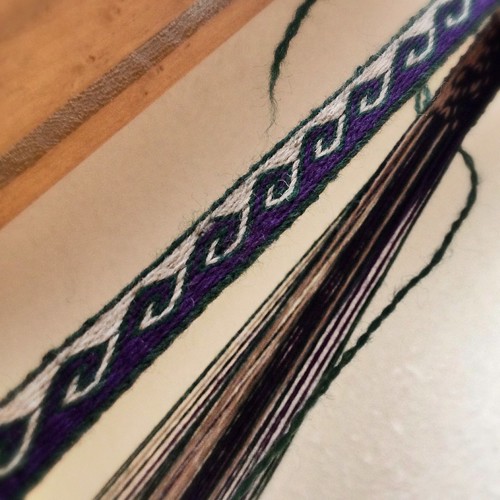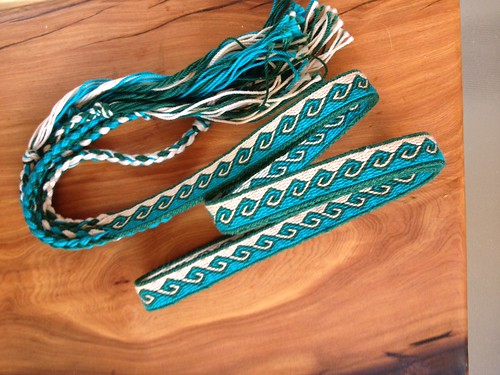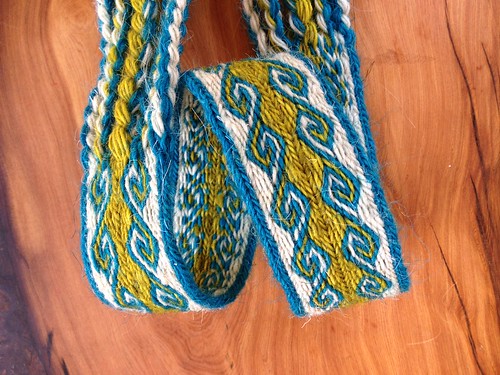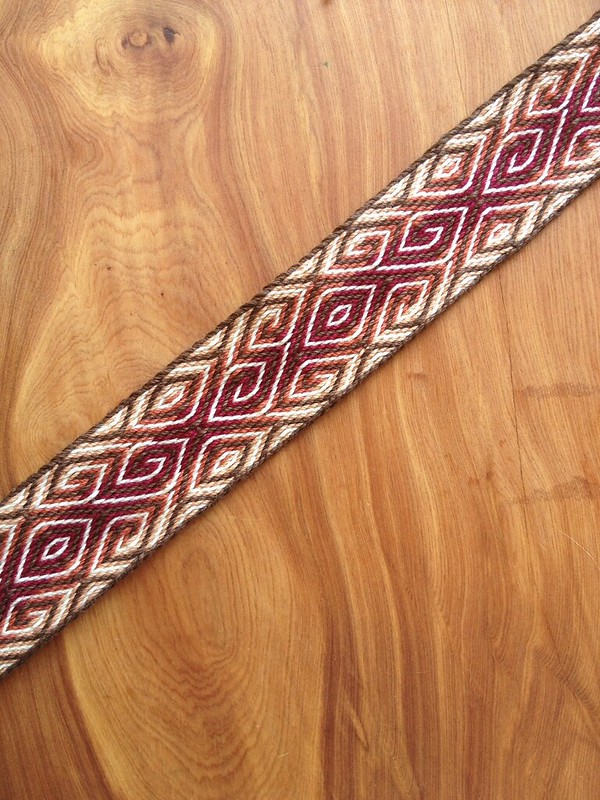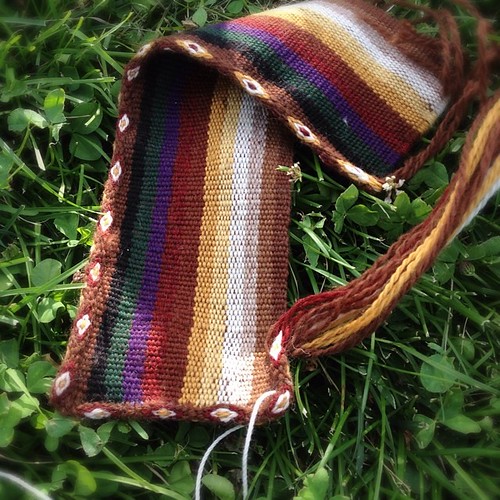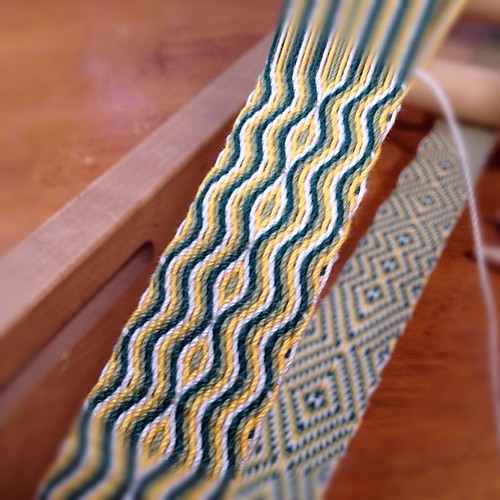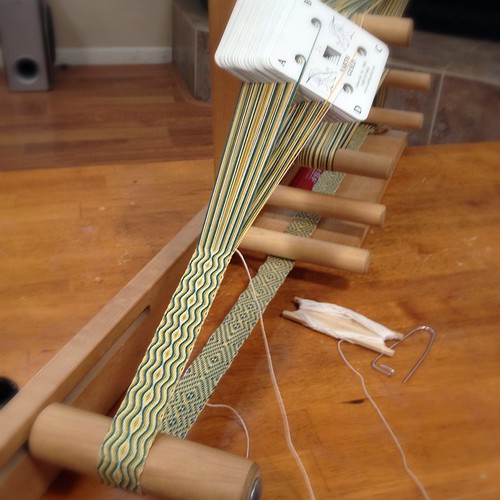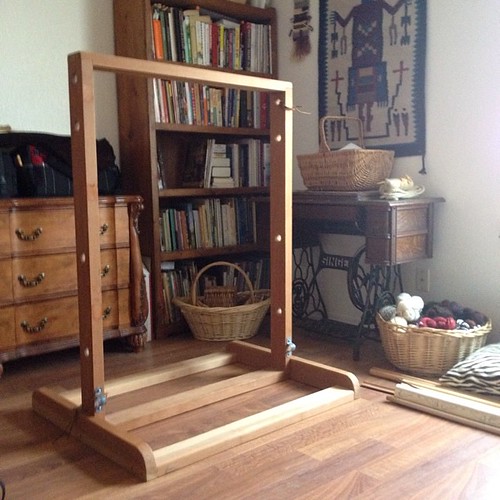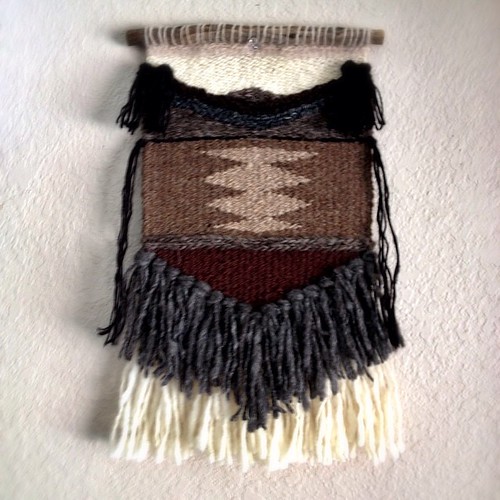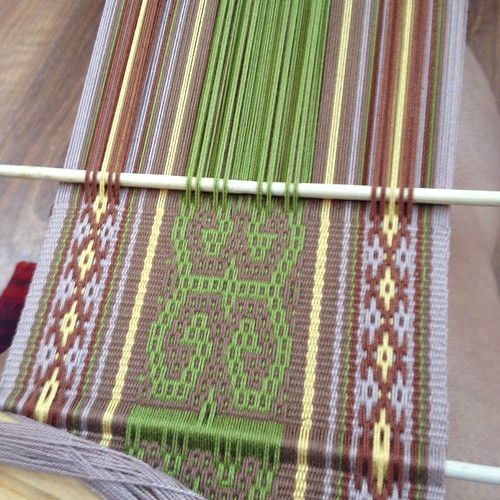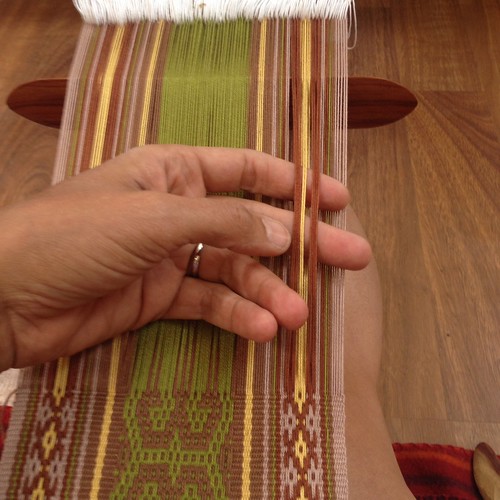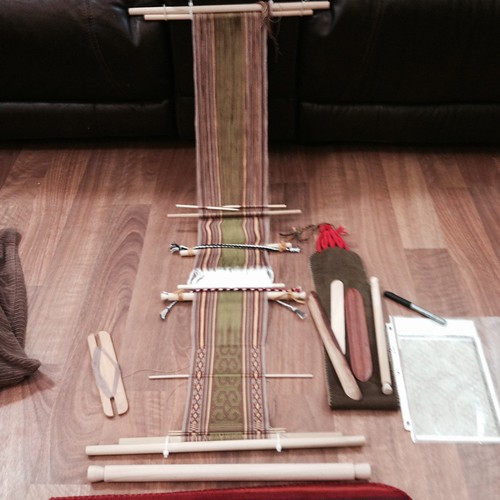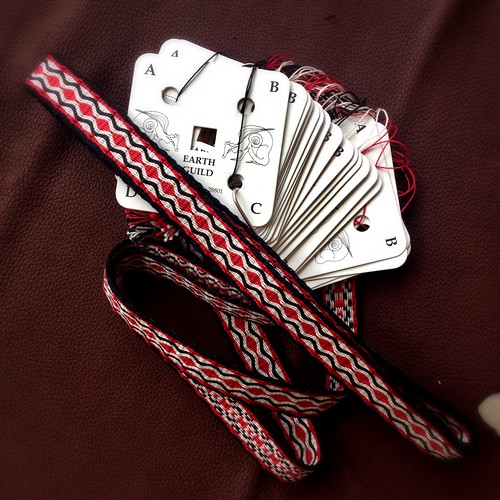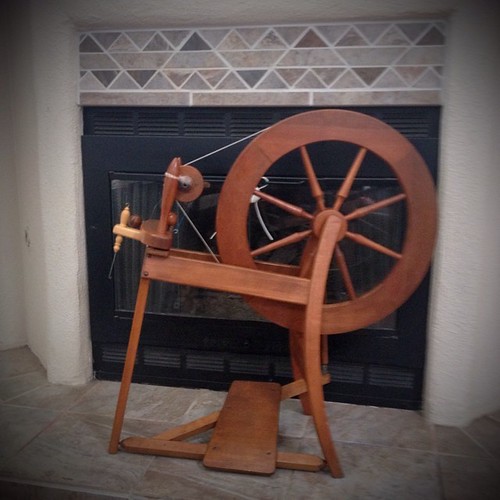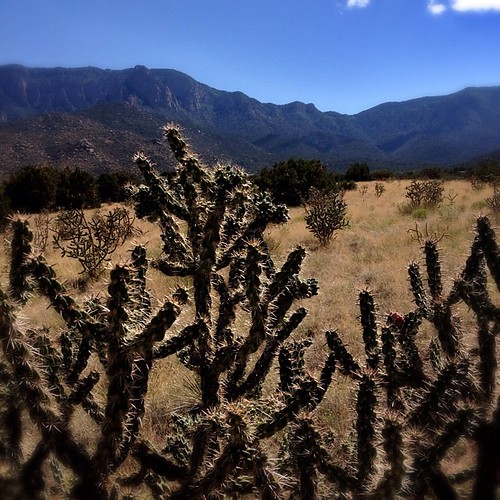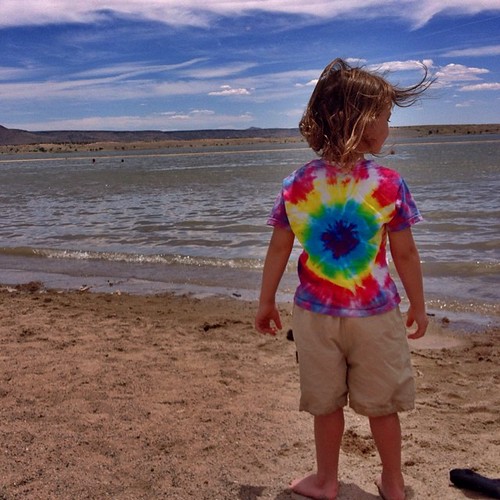As much as I've tried to stay away from "weaver speak" I had learn quite a bit to move forward in my tablet weaving. Warning (laugh), this post will get into "weaver speak" and I pre-apologize for any confusion, and welcome any questions, as this helps me to keep learning.
Continuing the year of learning for me, I admit that tablet weaving had been one of the simpler, mindless (in a way of its repetitiveness) weaving processes I've done. Until now, I've mostly done the 4 turns toward, 4 turns away type of bands. And these could go on forever, just in color combinations alone, the possibilities are endless.
I've always admired some of the more complex structures, and have tried a few over the years, managed to weave a couple, but not really knowing how the heck I did them. Somehow, they just came out.
When Interweave Store had one of their super sales, I decided to purchase John Mullarkey's Tablet Weaving Videos: Tablet Weaving Made Easy and Double Faced Tablet Weaving.
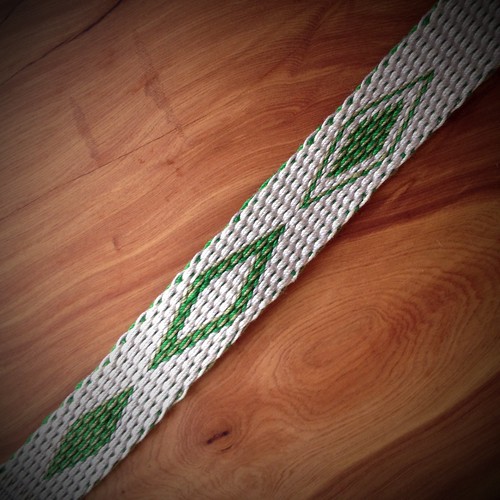 |
| my double faced weave sampler based off john mullarkey's video |
I can't tell you how much I really love these videos! I have them on my iPad, and it is just like having access to a classroom anytime. If I get confused, I can go to the appropriate section and refresh myself with the material. John Mullarkey is an excellent teacher (I was fortunate to sit in on one of his lectures at Convergence Albuquerque, where I also met Laverne Waddington, Linda Hendrickson, and a few others. At that time I was deep into Navajo Weaving, and just starting to become interested in Backstrap Weaving).
Even thou Tablet Weaving Made Easy starts you from stratch, I learned a lot, especially in regards to setup on the inkle loom. My Inkle Loom is my go to loom, and the one I can most easily have around my children without disaster (laughing). Just for this aspect alone, tablet weaving on an inkle loom is worth getting the video. Other perks is learning how to design drafts to weave. John Mullarkey also explains things in a way that is easily understandable.
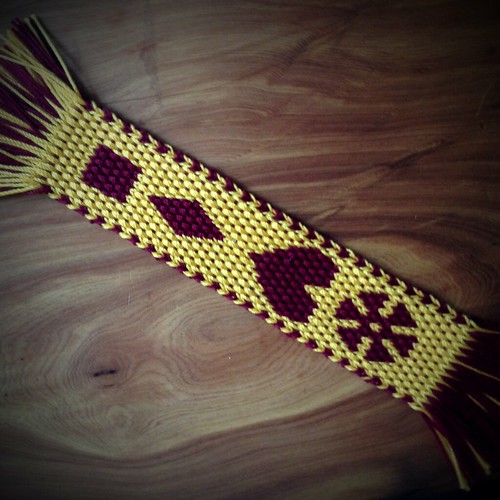 |
| a sampler based off a pattern from linda hendrickson |
In the past, when I've tried to do more complex set-ups, I feel what hung me up was "language". Each tablet weaver has their own language. To look up a draft in different resources meant different language, for example, towards, forward, and front can all mean the same thing when applied to the direction of turning tablets. For me, this was incredibly confusing as I moved onto "2 pack" techniques.
Warping my loom as instructed in the Double Faced Tablet Weaving video, I sat and worked thru the first 2 lessons: Doubled Faced All Threaded Z or S and Doubled Faced Threaded SZ. I really, really loved the second lesson, and my mind started whirling with the possibilities.
Searching online, I found some resources at Linda Hendrickson's website, and combined with the video, I moved on to do samplers. My biggest problems were the "language" and learning direction of twist. Once I was able to shift both weavers "language" into my own, my weaving took off.
Here are my goals and notes regarding this project:
Double Woven Tablet Band - SZ Threading - Sample #3
Goals for this project:
1. Using threaded-in tablets and a circular/continuous warp combined on the inkle loom.
2. To be able to identify an S or Z threaded tablet, then arrange them into an SZ order across the warp.
3. Continue practicing SZ Threaded Double Faced Weave.
4. Weaving with 2 tablets on each edge, turned in a consistent direction for selvedge.
5. Use a new brand of yarn (for me), noting how I like it, EPI, PPI, etc.
6. Try various patterrns/motifs.
7. Using either blue or green for the background color and/or weft.
8. Weaving the 2 pick sequence needed for double weave and identifying where I'm at if I stop in the middle of a sequence.
Equipment & Yarn Used:
- Schacht Inkle Loom, Snipes Shuttle
- Bernat Handicrafter (Crochet Thread) Size 5, Blue (@35g) and Green (@25g)
- Graph Paper, Post-it Notes, Pencil, Eraser, Ruler, Cardboard
Resources: Tablet Weaving Made Easy Video (John Mullarkey), Double Faced Tablet Weaving Video (John Mullarkey), Tablet Woven Leashes for Spike and Jones (Linda Hendrickson), Double Faced Tablet Weaving (Linda Hendrikson), Tablet Weaving Magic (Otfried Staudgel). Note: I do not own Tablet Weaving Magic yet, but I thought I'd include it here as I have reproduced and altered one of the motifs found in her book.
Threading: I threaded all the tablets Z. The first two and last two were threaded-in, all others were done using a continuous warp method found in the Double Faced Tablet Weaving video. Then I rearranged all the tablets to altenate for and SZ threading.
To Start Weaving: Selvedge tablets will always turn in the same direction. The rest of the cards will be woven will the double weave sequence: 2 turns towards and two turns away. Inserted pieces of cardboard for fringe.
PAW PRINT
The first paw print went great, but when I moved on to the second motif, where the background colors reversed, I became thoroughly confused. I practiced unweaving my mistakes (practice is the kind word, it was more like torture) and somehow managed to weave the second motif, althou I was not entirely clear on what I was doing.
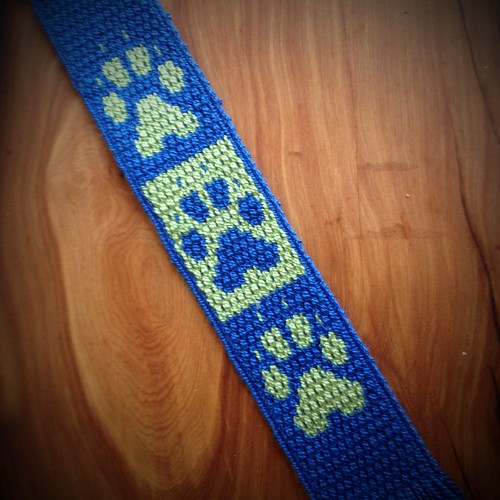 |
| .paw print. |
What I learned: Each tablet weaver has their own way or "language" they use to give directions on how to weave a motif, and I need to pay very close attention. What I realized was I needed to firmly understand in this "2 pack" technique which pack was the "background" pack and which was the "pattern" pack, and to choose a fixed position to move these packs into each 2 pick sequence. I know this sounds confusing, but it's the only was I can explain it. Once I firmly understood these conditions, the colors of the weaving (ie blue or green) became a weaving tool that I was turning the packs in the right direction.
KIMBERLEY
I graphed out my name for a bookmark. To deal with the twist build in the selvedge tablets I decided to change the turning direction. I was concerned this might confuse me, so I noted it on my draft.
 |
| .kimberley bookmark. |
What I learned: Weaving my name helped me to continue to learn how to separate out the background and pattern packs into their "fixed" positions, shifting the selvedge tablets to the approriate pack which helped me as an aid in turning direction.
GARRETT
I graphed out Garrett's name, changing the color scheme for the background color and chose to switch to using green weft instead of blue.
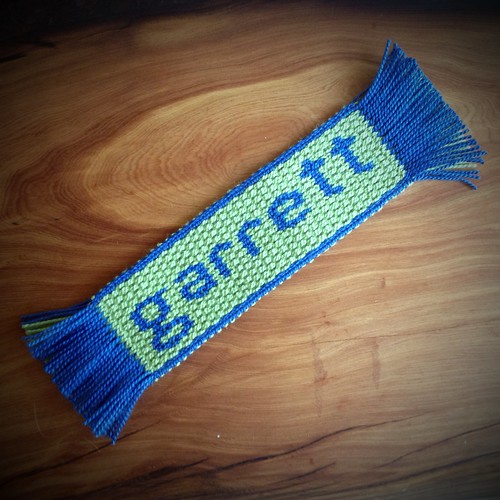 |
| .garrett backpack band. |
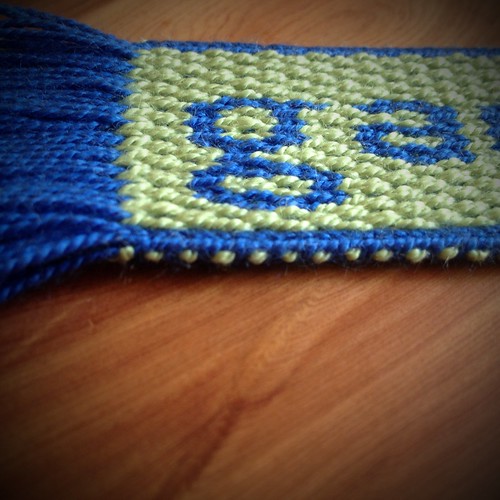 |
| close up of the weft |
What I learned: I decided to switch weft colors for 2 reasons: (1) when doing this type of weave a little bit of color can show thru in the weaving, which is fine, but I wanted that color to be all green instead of some blue, (2) I ended up loving the little bead of color along the edge that was produced by the contrasting colors. I was able to weave this segment with no problems, and if I did make an error in turning, I now can succesfully undo my mistake without it being stressful (big smile).
SAMPLE FOR MOTIFS AND TWIST DIRECTION
I graphed out a motif from a woven band that Linda Hendrickson did, she noted that the pattern was by Otfried Staudigel.
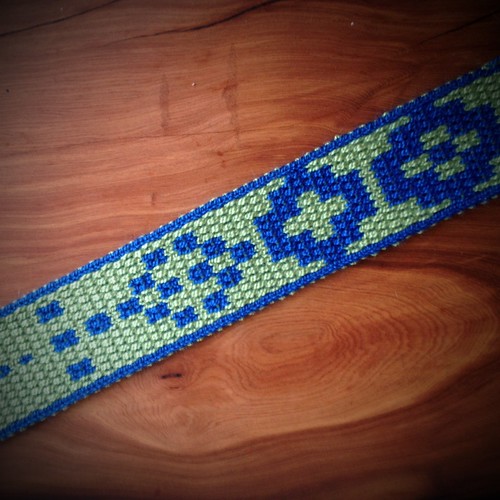 |
| sampler for direction of twist. |
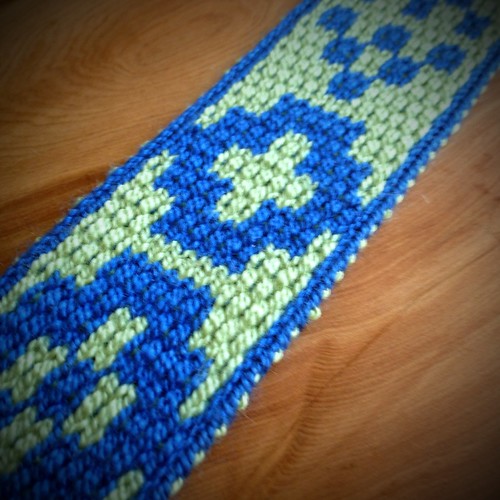 |
| sampler for direction of twist. |
What I learned: Before I started this portion, I went back to the Double Faced Tablet Weaving Video and re-watched the section on determining twist. Again, I can't recommend this video enough. The video was what enabled me to understand what I needed to do to follow my draft. Once I figured out the direction of twist in the woven band, patterns/motifs will come out right. This may sound vague, but I recommend the video as it does a perfect job of explaining this, and if you want to design patterns, this will be essential!
WYATT
Okay, here comes the fun! This band was a representation of all the goals I listed above.
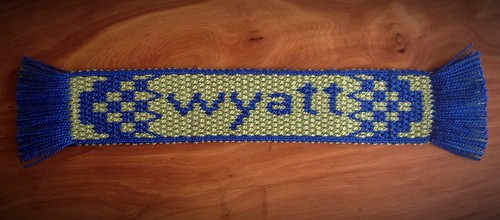 |
| .wyatt backpack band. |
It has threaded-in tablets for the selvedge. I turned those tablets in a continuous direction, shifting them back and forth between the background and pattern packs, using them as an aid for turning direction in conjunction to my written draft.
All the other tablets were strung using continuous/circular warp on the inkle loom. I then repositioned all the tablets in a SZ order. I can now firmly identify an S or Z threaded tablet (smiling).
 |
| .i am so happy with wyatt's band. |
I wove the 2 pick sequence needed for double faced weave, and I'm able to identify by (1) using my charted draft with notes and (2) looking at the position on tablets after 1 pick exactly where I was. This was a biggy for me, to be able to tell by looking at the tablets, and what color yarn was in what hole, where I was in the weaving sequence. It also helped me identify which pack was background/pattern. Everything finally fell together!
I used what I learned about direction of twist in the previous band as I drafted out Wyatt's band. I could now predict the slant/direction of twist which was needed in order for this pattern to work. I didn't mess up!
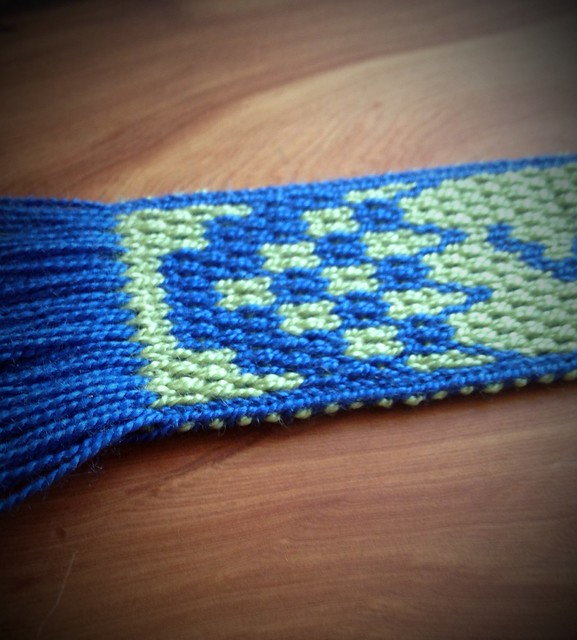 |
| close up of weft and selvedge. |
For the weft I choose green again for design purposes, and I got that cool little bead of color along the edge.
And lastly, it didn't kill me to use a yarn with nylon. I typical use 100% cotton, or 100% wool (natural fibers). I don't know how this yarn will wear, it's has this odd fuzzy thing happening, and I think the ends are going to fray quite a bit. I'm not going to bother detailing EPI and such here because if I've learned anything, this can vary dramatically depending on the equipment and the weaver.
I have yet to press these with an iron (I am going to skip washing them), and the bands with my sons' names will be sewn to their school backpacks.
Oh, one more thing, I wove a bit different this time, leaving a loop at the end of each row, and pulled it thru on the next row, it worked better for me.
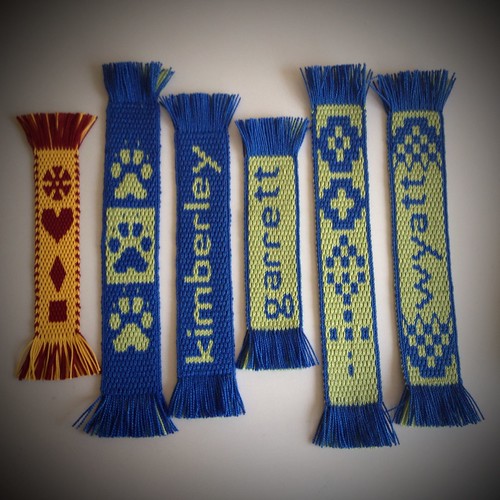 |
| .all the bands. |

